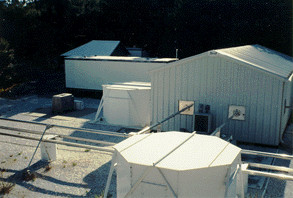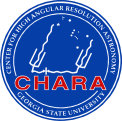What is CHARA?
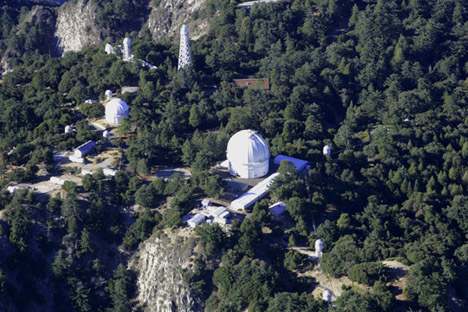
The flagship project of Georgia State University's Center for High Angular Resolution Astronomy (CHARA) is its optical interferometric array of six telescopes located at Mount Wilson Observatory in Southern California. Each telescope of the CHARA Array has a light-collecting mirror 1-meter in diameter. The telescopes are dispersed over the mountain to provide a two-dimensional layout that provides the resolving capability (but not the light collecting ability!) of a single telescope with a diameter of 330 meters (one fifth of a mile)! Light from the individual telescopes is transported through vacuum tubes to a central Beam Synthesis Facility in which the six beams are combined together. When the paths of the individual beams are matched to an accuracy of less than one micron, after the light traverses distances of hundreds of meters, the Array then acts like a single coherent telescope for the purposes of achieving exceptionally high angular resolution. The Array is capable of resolving details as small as 200 micro-arcseconds, equivalent to the angular size of a nickel seen from a distance of 10,000 miles. In terms of the number and size of its individual telescopes, its ability to operate at visible and near infrared wavelengths, and its longest baselines of 330 meters, the CHARA Array is arguably the most powerful instrument of its kind in the world.
Science Objectives
The CHARA Array is applicable to problems in almost all areas of contemporary astronomy. It is particularly suited to stellar astrophysics where it can be used to study stellar structure and evolution. The CHARA Array is used to measure the angular diameters of stars of all sizes, from hot massive stars to cool low mass stars, and at different stages of evolution, from the sun-like stars to evolved giant and supergiant stars. Observations at the CHARA Array can reveal the oblate shapes of rapidly rotating stars. It can also be used to image the surfaces of stars, resolving features such as spots on magnetically active stars and convection cells on supergiant stars. The CHARA Array can detect close binary companions and map their orbits over time. The CHARA Array can resolve the inner regions of planet forming disks around young stars and the circumstellar environments around old stars. It can also study changes in transient event, like measuring the expansion of novae explosions.
Building the CHARA Array
Encouraged by the success of the program of binary star speckle interferometry initiated at Georgia State in 1977, the Center for High Angular Resolution Astronomy (CHARA) was established in 1984 with the goal of promoting, designing, funding and operating a major new instrument capable of achieving new levels of angular resolution. Such an instrument would be able to measure the sizes of thousands of stars, see the individual components of binary stars gravitationally bound together in orbits having periods as short as one day, and even detect and image surface details on stars whose existence has only been inferred.
Preliminary planning for this new instrument began in earnest in 1985 with seed money from the National Science Foundation. The NSF provided additional support for detailed engineering studies in 1992 and in October 1994 awarded Georgia State $5.6-million towards construction of a five-telescope array. Additional supplements increased the NSF capital investment to nearly $6.3-million. Over the course of construction of the project, the University has provided matching funds in a similar amount. Following a final site selection process, Mount Wilson, California, home of the historic Mount Wilson Observatory, was selected as the site for the CHARA Array. Ground was broken on July 13, 1996.
In July 1998, the W.M. Keck Foundation awarded Georgia State $1.5-million to add a sixth telescope and to improve the beam combination instrumentation. Funding for the project was completed in October 1998 with a gift from the David and Lucile Packard Foundation of $574,000.
A significant milestone in the project was the attainment of "first fringes" from our southern pair of telescopes in November 1999. This demonstrated the basic soundness of the design for the many subsystems of the Array and gave added confidence that the instrument could meet its scientific goals.
With nearly 300 people in attendance, the CHARA Array was dedicated on October 4, 2000. On September 19, 2001 the Array achieved starlight fringes on its 331-meter baseline, the longest baseline (by a factor of three) ever achieved by an optical interferometer. The Cleon C. Arrington Remote Operations Center for the CHARA Array, located on the Georgia State campus in Atlanta, was dedicated on February 28, 2002. This facility is permitting GSU faculty, staff and students to participate in observing activities at the Array on Mt. Wilson, enabling the remote control of all CHARA facilities from across the country.
By the end of 2002, the Array had made the transition to an active science instrument, and the NSF awarded CHARA a new three-year grant to support scientific programs in April 2003 and renewed that support for another three-year term in 2006. While the construction of the CHARA Array was completed in 2003, technical improvements in both hardware and software will continue indefinitely. Indeed, one rationale for the facility is to serve as a testbed for new developments in optical interferometry.
With this in mind, CHARA has entered into several collaborations with groups offering unique instruments or technologies for enhanced performance. At present these collaborations include a joint observing effort with astronomers from the Laboratoire d'Etudes Spatiales et d'Instumentation en Astrophysique (LESIA) of the Observatoire de Paris who have located their "Fiber Linked Unit for Optical Recombination" (FLUOR) at the CHARA Beam Synthesis Facility. A collaboration with astronomers from the University of Michigan has led to the development of an imaging beam combiner (MIRC) which has produced the first images of stellar surfaces and close binary stars. An agreement between GSU and L'Observatoire de la Cote d'Azur (France) has brought VEGA beam combiner to the Array capable of providing spectroscopic and polarimetric channels for high spectral resolution work. Finally, a joint project between CHARA and astronomers from the University of Sydney (Australia) has led to the development the PAVO beam combiner with significantly improved sensitivity to fainter objects while also providing measurements of very high precision. These international collaborations have brought significant added value to the science capabilities of the CHARA Array.
With growing demand in the astronomical community for high resolution observations obtained through long baseline interferometry, CHARA initiated an open access program in 2010. Initially, CHARA offered a small amount of time consisting of 5-10 nights per year to the broader community as a trial program. Starting in 2016, CHARA received funding through the National Science Foundation's Mid-Scale Innovations Program to expand the open access time to 50-75 nights per year to the astronomical community. Astronomers can apply for time at the CHARA Array through the time allocation process at the National Optical-Infrared Astronomy Research Laboratory (NOIRLab). Demand for time at the Array is high with an average over-subscription rate of 2.1. As of 2020, almost 300 astronomers from across the country and around the world have applied for time through the open access program.
The next generation of instrumentation is underway at the CHARA Array. Implementation of adaptive optics systems at each of the six CHARA telescopes is complete. In a collaboration between the University of Exeter and the University of Michigan, the MIRC-X beam combiner was recently upgraded with an ultra-low read noise detector and new input optics to improve sensitivity and wavelength coverage. The University of Michigan installed a six-telescope cryogenic beam combiner called MYSTIC that operates at longer wavelengths. The team at l'Observatoire de la Cote d'Azur built the next generation optical instrument SPICA that combines all six-telescopes and provide a range of spectral dispersions at visible wavelengths. Georgia State University is commissioning a new combiner Silmaril that will push the sensitivity limits of the Array.
Take a photo tour of the CHARA Array.
History of Interferometry at Mount Wilson
The following picture depicts what Mount Wilson looked like just prior to construction of the CHARA Array. For more information on the history the Observatory, visit the Mount Wilson website.
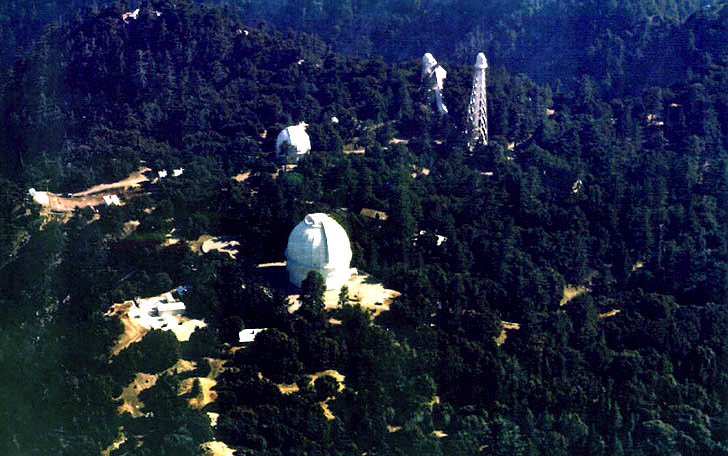
CHARA is not the first interferometer at Mount Wilson.
The Michelson interferometer
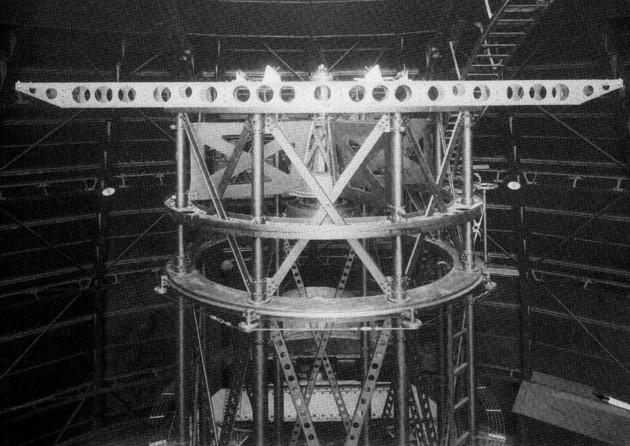
The Pease interferometer
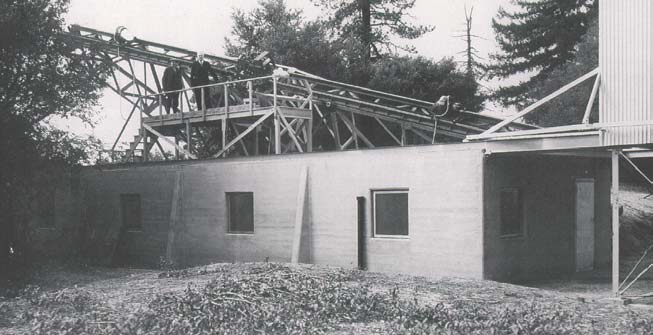
The Mark III interferometer
